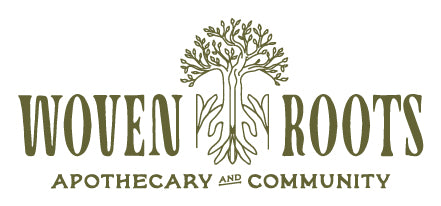As we start our journey of participating in markets and pop-up events, we have been particularly focused on and excited about our teas.
And it’s true–we are super stoked and proud of our teas. AND. Tea is just one part of what we want to offer. We don’t want to lose sight of our larger vision and mission–to foster strength through connection to self, others, and the Earth, in order to promote health and healing for all.
So what does tea have to do with connecting to ourselves?
A cup of tea is a sensory experience: I can see the leaves, roots, and flowers; I can feel the warmth of my cup in my hands; I can smell it, taste it, and feel the warmth moving through my body. I can savor the tea and the moment we co-create, carving out an opportunity for mindfulness and intention. I can be more in my body.
Additionally, the herbs in the tea offer supportive benefits and work with my body in a way that can promote increased awareness or help ease obstacles that might make it harder to connect with my body, such as pain or anxiety.
In short, a cup of tea is a regulatory activity.
Regulation–this is a buzzword I hear a lot these days, and from my perspective as a somatic therapist, I believe this word is too often used with significant limitations. I hear the word regulation being equated with moving away from a particular feeling or state, or calming down.
But here’s the thing: REGULATION DOES NOT MEAN CALM. Sometimes the effect of regulation is calming, but to equate the two is to eliminate, or in some cases even villainize, the rest of a vast spectrum of emotions, a spectrum which is actually vital to our adaptability and well-being. Biasing calm can have a numbing effect, and for some people, the expectation of calm can elicit shame or self-criticism when they aren’t able to calm down.
The reality is calm is not always what the moment calls for. Sometimes we need to get a little revved up. Sometimes it makes sense to feel frustrated or agitated. Sometimes it is appropriate to feel sad or even enraged. And for the sake of our adaptability, our health and wholeness, we need to be able to register and respond to these cues from our bodies, something that might be very hard to do if we are overly focused on calming down.
But again, regulation does not mean calm. This means that we can regulate in whatever state we’re in…well, so long as the emotion is a tolerable range for us, but that’s for another blog.
So what does regulation mean? Regulation means connection: it’s our ability to stay connected to ourselves even when we’re experiencing big feelings so that we can manage those feelings and our responses to them; it’s our ability to come back to ourselves after those moments we become flooded or overwhelmed by our big feelings (let’s face it, we all have those moments. And for good reason! Life can be overwhelming); it’s our courageous openness and ability to be with ourselves in all of our emotions, moving with and through them rather than out and away from them.
As I said previously, a cup of tea is a regulatory activity. Sometimes tea might help me calm down, and other times tea might help me feel a little more able to handle the stress I’m facing, or like I have a little bit bigger container to hold the grief or sadness I’m feeling, or a little less caught up in anxiety. In other words, a cup of tea can help me connect to myself in whatever I’m experiencing, aka regulate.
Stay tuned…let’s build on this and talk about what tea and regulation have to do with connecting more with each other.

